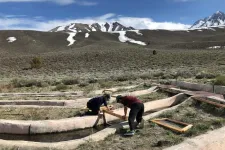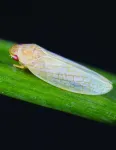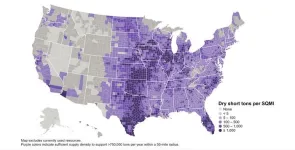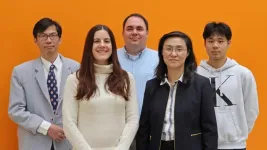(Press-News.org) Heparin, the world’s most widely used blood thinner, is used during procedures ranging from kidney dialysis to open heart surgery. Currently, heparin is derived from pig intestines, but scientists at Rensselaer Polytechnic Institute have discovered how to make it in the lab. They have also developed a path to a biomanufacturing process that could potentially revolutionize how the world gets its supply of this crucial medicine.
“In recent years, with disease and contamination issues disrupting the global supply chain of pig heparin and potentially putting millions of patients at risk, it’s clear we need to diversify the way we make this drug,” said Jonathan Dordick, Ph.D., Institute Professor of Chemical and Biological Engineering, and vice president of Strategic Alliances and Translation at RPI. “Our work will make it possible to manufacture heparin that is both consistently available and safe.”
With their patented process, detailed in a study published in the journal PNAS, the researchers are already working with FDA and have initiated scale-up leading to commercial production.
“While the current study describes the laboratory-scale production of heparin, we are also moving toward a commercial-scale process, affording the same high quality heparin, to generate the drug for clinical studies,” said Robert Linhardt, Ph.D., Ann and John H. Broadbent Jr. ’59 Senior Constellation Professor Emeritus of Biocatalysis and Metabolic Engineering at RPI and a co-author of the study. Both Dordick and Linhardt are members of RPI’s Shirley Ann Jackson Center for Biotechnology and Interdisciplinary Studies.
“This multidisciplinary research is a prime example of how discoveries made in the lab can successfully translate into new tools to advance global health,” said Shekhar Garde, Ph.D., dean of the RPI School of Engineering.
Recognized by the World Health Organization as an essential medicine, heparin is always in high demand. To meet the need, the intestines of billions of pigs are processed annually, producing about 100 tons of purified heparin. More than 70% of the supply comes from China.
Animal-based products are susceptible to shortages, and heparin is no exception. The 2008 heparin contamination crisis, recurring swine diseases outbreaks, and the supply chain issues of the COVID-19 pandemic have all disrupted heparin availability, prompting researchers to investigate how to make heparin without animals.
At RPI, the quest for non-animal heparin led to the creation of the Heparin Applied Research Center in 2015. Over the next several years, the team of scientists developed a novel method of synthesizing heparin that would not only be virtually indistinguishable from animal-derived heparin but could also be made at scale.
“Heparin was discovered more than 100 years ago, but only recently have we had the techniques to start trying to make it in the lab,” said Dordick, senior author of the study. “Unlike insulin — another very important medicine that used to come from pigs and is now man-made — heparin isn’t just a single protein or molecule, but a complex chain of various carbohydrates. That makes it very hard to synthesize in a way that translates into a more traditional large manufacturing setting.”
Dordick likens synthesizing heparin in the lab to decorating a Christmas tree.
“We start with the core of the heparin structure, which is like the bare tree. Then, using various enzymes, we add molecules — the ornaments, the tinsel, the lights. As you can imagine, there are many ways to decorate a tree, so getting the decoration just right to make heparin is the challenge,” he said.
In recent decades, scientific teams around the world have been attempting to do just that, but without success.
“Past research used native enzymes to replicate what happens in pig intestines to make heparin. However, this produces a tiny amount of heparin and can’t be done at scale. Our biggest achievement was the insight to optimize the enzymes for higher yield and stability,” said Elena Paskaleva, Ph.D., senior research scientist at RPI and one of the study’s co-authors.
“Synthesizing those enzymes in such large scale was uncharted territory for us in an academic lab,” said Marc Douaisi, Ph.D., first author of the study and senior research scientist RPI. “It took a large, coordinated effort across the whole center to synthesize the volume needed to synthesize a product with a structure and biological activity equivalent to the pig-derived drug. At the end of the day, it was exhilarating to know that what we ultimately made matched all the criteria of heparin.”
The discovery is an example of how universities can drive research and development of new life-saving drugs and technologies, Dordick said.
“Our goal was to find an alternative to a drug that’s been on the market since 1935. For a private company, that kind of project would bring too much risk. But a university, especially one like RPI, is the perfect place to pursue this kind of project,” Dordick said.
END
Scientists’ discovery could reduce dependence on animals for vital anti-blood clot drug
The patented finding could transform the way the world produces the blood thinner heparin
2024-03-18
ELSE PRESS RELEASES FROM THIS DATE:
Artificial streams reveal how drought shapes California’s alpine ecosystems
2024-03-18
Berkeley — A network of artificial streams is teaching scientists how California’s mountain waterways — and the ecosystems that depend on them — may be impacted by a warmer, drier climate.
Over the next century, climate change is projected to bring less snowfall to the Sierra Nevada. Smaller snowpacks, paired with warmer conditions, will shift the annual snowmelt earlier into the year, leaving less water to feed streams and rivers during the hot summer months. By 2100, mountain streams are predicted to reach their annual base, or “low-flow,” conditions an average of six ...
Not in my backyard? Wind turbines have little effect on US property values
2024-03-18
“The impact of wind turbines on house prices is much smaller than generally feared: In the U.S., it’s about one percent for a house that has at least one wind turbine in a 10 km radius”, explains Maximilian Auffhammer, a Professor in the Department of Agricultural and Resource Economics at the University of California, Berkeley and co-author of the study. “And what really surprised me is that the house value bounces back to the original price over the years.” The study authors also found that there was no longer any ...
The costs of a changing landscape
2024-03-18
UNDER EMBARGO UNTIL MARCH 18, 2024 AT 3:00 PM U.S. EASTERN TIME
Renewable energy sources are essential for transitioning towards a decarbonized energy system and making the electricity grid more environmentally sustainable. Clean energy alternatives like wind power can effectively replace fossil fuels, contributing to reduced air pollution and slow down climate change.
Wind power has emerged as the fastest-growing non-hydro renewable energy source worldwide. However, the implementation of wind energy infrastructure, including windmills, faces significant challenges. One major obstacle is the opposition from local communities.
Wind turbines, the primary ...
UMD researchers develop genomic method of monitoring for pesticide resistance
2024-03-18
Farmers rely on pesticides to control agricultural pests. But insects often develop resistance to the toxins in pesticides. University of Maryland researchers have developed and successfully tested a strategy for using genomics to monitor for and identify emerging resistance to specific toxins early, well before it becomes a widespread problem. The work will enable farmers to mitigate resistance and prolong the effectiveness of pest management tools.
The research was published on March 18, 2024, in the Proceedings of ...
Backyard insect inspires invisibility devices, next gen tech
2024-03-18
UNIVERSITY PARK, Pa. — Leafhoppers, a common backyard insect, secrete and coat themselves in tiny mysterious particles that could provide both the inspiration and the instructions for next-generation technology, according to a new study led by Penn State researchers. In a first, the team precisely replicated the complex geometry of these particles, called brochosomes, and elucidated a better understanding of how they absorb both visible and ultraviolet light.
This could allow the development of bioinspired optical materials with possible applications ranging from invisible cloaking devices to coatings to more efficiently harvest ...
Americans support democratic norms, elected officials don't
2024-03-18
Following the attack on the U.S. Capitol on Jan. 6, 2021, and efforts to overturn the results of the 2020 presidential election, many Americans have raised concerns about the future of democracy in the United States.
Yet the American public, including Democrats and Republicans alike, strongly oppose anti-democratic actions and partisan violence, according to a new study by the Polarization Research Lab.
"Democracy is under threat in America, but these data show we are not on the brink of a citizen-supported push toward authoritarianism," says the lab's ...
Harnessing hydrogen at life’s origin
2024-03-18
A new report uncovers how hydrogen gas, the energy of the future, provided energy in the past, at the origin of life 4 billion years ago. Hydrogen gas is clean fuel. It burns with oxygen in the air to provide energy with no CO2. Hydrogen is a key to sustainable energy for the future. Though humans are just now coming to realize the benefits of hydrogen gas (H2 in chemical shorthand), microbes have known that H2 is good fuel for as long as there has been life on Earth. Hydrogen is ancient energy. The very first cells on Earth lived from H2 produced in hydrothermal vents, using the reaction of H2 with CO2 to make the molecules of ...
Sustainable biomass production capacity could triple US bioeconomy, report finds
2024-03-18
The United States could triple its current bioeconomy by producing more than 1 billion tons per year of plant-based biomass for renewable fuels, while meeting projected demands for food, feed, fiber, conventional forest products and exports, according to the Department of Energy’s latest Billion-Ton Report led by Oak Ridge National Laboratory.
The 2023 Billion-Ton Report, or BT23, announced by DOE, is the fourth in a series of national biomass resource assessments spanning two decades. The report identifies feedstocks that could be ...
Cure Mito Foundation and Hope for PDCD Foundation announce a patient registry collaboration
2024-03-18
March 18, 2024 – Cure Mito Foundation and Hope for PDCD foundation, both patient-led foundations focused on advancing research and supporting families affected by Leigh syndrome and Pyruvate Dehydrogenase Complex Deficiency (PDCD), respectively, are excited to announce a launch of a PDCD patient registry. This innovative registry will be led by the Hope for PDCD foundation and hosted on the same registry platform as the well-established Leigh Syndrome patient registry, developed by the Cure Mito Foundation. This strategic move is aimed at enhancing patient convenience and improving data alignment and research ...
Newborn piglets serve as a model for studying influenza
2024-03-18
Although prevention and treatment strategies are available for influenza, they are not sufficient for vulnerable populations such as young children and newborns. In a new study, published in Virology, a multidisciplinary team of researchers have studied newborn piglets to better understand the progression of influenza infections.
The influenza A virus can infect a variety of birds and mammals, including humans and pigs, due to which it is a threat to public health and food security. While it causes mild ...
LAST 30 PRESS RELEASES:
Interaction of climate change and human activity and its impact on plant diversity in Qinghai-Tibet plateau
From addressing uncertainty to national strategy: an interpretation of Professor Lim Siong Guan’s views
Clinical trials on AI language model use in digestive healthcare
Scientists improve robotic visual–inertial trajectory localization accuracy using cross-modal interaction and selection techniques
Correlation between cancer cachexia and immune-related adverse events in HCC
Human adipose tissue: a new source for functional organoids
Metro lines double as freight highways during off-peak hours, Beijing study shows
Biomedical functions and applications of nanomaterials in tumor diagnosis and treatment: perspectives from ophthalmic oncology
3D imaging unveils how passivation improves perovskite solar cell performance
Enriching framework Al sites in 8-membered rings of Cu-SSZ-39 zeolite to enhance low-temperature ammonia selective catalytic reduction performance
AI-powered RNA drug development: a new frontier in therapeutics
Decoupling the HOR enhancement on PtRu: Dynamically matching interfacial water to reaction coordinates
Sulfur isn’t poisonous when it synergistically acts with phosphine in olefins hydroformylation
URI researchers uncover molecular mechanisms behind speciation in corals
Chitin based carbon aerogel offers a cleaner way to store thermal energy
Tracing hidden sources of nitrate pollution in rapidly changing rural urban landscapes
Viruses on plastic pollution may quietly accelerate the spread of antibiotic resistance
Three UH Rainbow Babies & Children’s faculty elected to prestigious American Pediatric Society
Tunnel resilience models unveiled to aid post-earthquake recovery
Satellite communication systems: the future of 5G/6G connectivity
Space computing power networks: a new frontier for satellite technologies
Experiments advance potential of protein that makes hydrogen sulfide as a therapeutic target for Alzheimer’s disease
Examining private equity’s role in fertility care
Current Molecular Pharmacology achieves a landmark: real-time CiteScore advances to 7.2
Skeletal muscle epigenetic clocks developed using postmortem tissue from an Asian population
Estimating unemployment rates with social media data
Climate policies can backfire by eroding “green” values, study finds
Too much screen time too soon? A*STAR study links infant screen exposure to brain changes and teen anxiety
Global psychiatry mourns Professor Dan Stein, visionary who transformed mental health science across Africa and beyond
KIST develops eco-friendly palladium recovery technology to safeguard resource security
[Press-News.org] Scientists’ discovery could reduce dependence on animals for vital anti-blood clot drugThe patented finding could transform the way the world produces the blood thinner heparin





